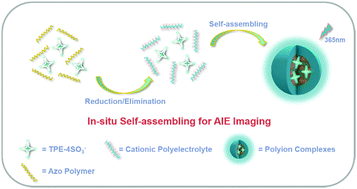Tianhao Xue, Kuanchun Shao, Jingyuan Xiang, Xinyi Pan, Zixuan Zhu and Yaning He
Nanoscale, 2020,12, 7509-7513
DOI:
10.1039/D0NR00444H,
Communication
This communication reported a hypoxia-responsive fluorescent probe based on the in situ concept, which combines a water-soluble azobenzene containing copolymer with a carbamate linkage and an anionic water-soluble aggregation-induced emission fluorogen (AIEgen) tetraphenylethene (TPE). The water-soluble copolymer can be transformed into a protonated primary amine containing polymer by the reduction of the azo bond and through a 1,6-self elimination cascade reaction under hypoxic conditions. The transition of anionic TPE from the molecular dispersed state to the aggregation state induced by self-assembly with the cationic polymer would lead to an obvious increase in fluorescence according to the AIE characteristics.
